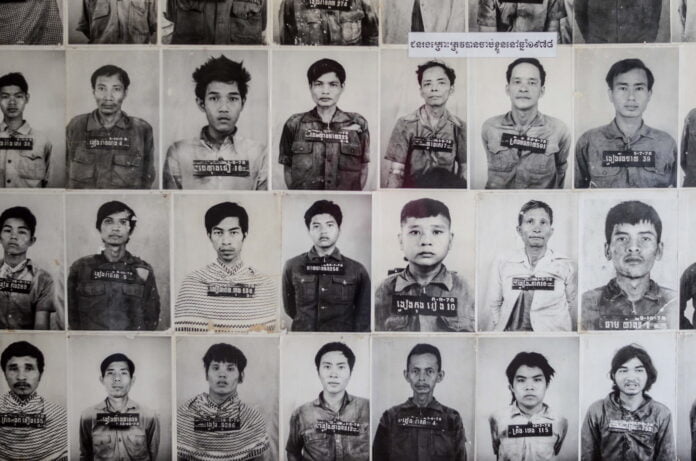Cambodia is often referred to as a “young country” – the devastation of an entire generation under the Khmer Rouge regime means that today’s Cambodia has a majority population under 25 years old and is still in the beginnings of bringing basic infrastructure to many rural areas. However, human habitation of the area dates back to 6th millennium BC, and, of course, the enormous and now-famous Khmer Empire of the 9th-13th century AD with its center piece of Angkor Wat gives Cambodia special historical significance in South East Asia.
Early civilizations
Laang Spean (Cave of Bridges) in Battambang Province in the northwest of Cambodia is home to a documented Hoabhinian site (period of Southeast Asian prehistory from about 13,000 to 3000 BC). Excavated in the 1960s by French archaeologists, the site produced flaked stone tools characteristic of the era, as well as earthenware ceramics though to be from the Neolithic period. It is thought that several historic sites in Cambodia may overlie pre-historic remains, but there is little archaeological record for much of the prehistoric era.
Funan and Chenla
The Funanese period and Chenla period, occurring between the 3rd – 6th centuries CE were culturally continuous Kingdoms linking eastern India and southern China to the islands of the South Seas. It is thought that, at its height, Funan extended as far west as Burma and south to Malaysia, taking in much of what is now Thailand and South Vietnam. Both civilizations were heavily influenced by trade with India, leading to the adoption of many Hindu religious beliefs that came to gain importance in later Khmer culture. It is unlikely that these Kingdoms were great ruling powers over the whole region; rather they were composed of different states or principalities supported through trade and intermarriage – and sometimes at war with each other.
Khmer Empire
The holy mountain of Phnom Kulen, just north of today’s Siem Reap, has attracted recent attention from archaeologists due to a mapping project which has identified the legendary ancient royal capital city of Mahendraparvata. Commonly called the birthplace of the Khmer empire, inscriptions on the mountain tell of Jayavarman II, proclaiming himself a ‘universal monarch’ in 802. Jayavarman II was the first in a succession of kings that held sway over this golden age of Khmer civilization. Most famous from this period, is, of course, the development of Angkor Wat in the early 12th century and the surrounding temples. However equally impressive (and essential for the construction of the temples) was the taming of the watery Kingdom with huge irrigation systems that not only supported agriculture but which were also linked to the foundations and stability of the temples themselves. This period is still thought of as the birthplace of many of the cultures, language and traditions of the entire region.
Dark Ages
After the death of Jayavarman VII (responsible for the construction of Ta Prohm, Angkor Thom and Bayon, the Khmer empire went into a period of decline, ending with a successful Thai invasion in 1431. The following 400 years is referred to as the “dark ages” of Cambodia, with its neighbors Siam and Vietnam fighting for dominance over the region.
French Protectorate
It is difficult to say whether King Norodom (ruler from 1860 to 1904) “requested” Cambodia to become a French protectorate in 1867, as it’s possible that his feelings were influenced by French naval military presence in the country. However, this agreement did do a great deal to re-establish Cambodia as an independent Kingdom and prevent it from being completely pulled apart and consumed by its neighbors. The French influence over Cambodia brought about many political changes (including ending slavery) and brought much international attention to the country through the “discovery” of the Angkor temples. However there was also resistance to the French, which surfaced in active rebellion in the late 19th century, and in academic and political movements in the 1940s.
Independence
World War II brought more instability to the entire region with at one point the Japanese occupying Cambodia. King Sihanouk (monarch from 1941 to 1955 and again from 1993 to 2004) was in a precarious position, trying to negotiate for independence, while not leaving his country too vulnerable in face of the difficulties brewing between the USA and Vietnam. Much has been written about Sihanouk’s political maneuvers at the time (in 1952 he dismissed his cabinet, suspended the constitution, and assumed control of the government, introducing martial law) but the situation was so complex it is hard to say, even in retrospect, what would have ultimately been best for the safety of Cambodia and its people. As it was, Sihanouk managed to secure complete independence in 1953.
Civil War
Sihanouk tried to maintain Cambodia’s international neutrality in the messy period of the Vietnam war and, in doing so, some say he lost the battle at home. Throughout the 1960s political unrest grew in Cambodia, and resulted in Sihanouk’s removal from power by Lon Nol in 1970. Lon Nol’s administration proved disastrous however, prompting Vietnamese invasion, civil war and encouraging the USA to carpet bomb massive parts of the country. This unrest bolstered support for the newly formed Khmer Rouge (literally “Red” Khmer) who captured Phnom Penh on April 17th 1975. Initially welcomed by the people as the saviors of their nation from the forces of the USA and Vietnam, the jubilation at the Khmer Rouge’s victory waned immediately. Within hours, Khmer Rouge forces evacuated the entire city of Phnom Penh on enforced marches into the countryside. Separating parents from children, husbands from wives, sisters from brothers, the Khmer Rouge enforced a brutal agrarian peasant society, destroying the values of family and replacing them with loyalty to the “Ongkar” – the party. Time was declared to be year zero, currency was destroyed and the country was closed to all international communication and influence. A new, tragic period of Cambodian history had begun.
Khmer Rouge
During the 3 years, 8 months and 20 days of the Khmer Rouge regime, is it estimated around 2 million people died – that’s a quarter of Cambodia’s entire population. Many of these were ordinary farmers, dying from starvation, overwork, or simple diseases that were left untreated due to the Khmer Rouge’s rejection of most medicinal practices. In addition, many people were executed in what are now known as Killing Fields. Anyone who was suspected to have a connection to the previous regime was murdered without trial. This meant that the majority of the educated population was either killed or fled the country.
However, Pol Pot’s control over the Khmer Rouge across the country was never particularly stable due to in-fighting and intense paranoia. The breakdown of relations with Vietnam ultimately led to a Vietnamese invasion, supported by many dissatisfied former Khmer Rouge members. In January 1979 Phnom Penh was captured and the Khmer Rouge collapsed, enabling a devastated population to gradually return to their homes, attempt to survive and rebuild their lives.
While the Khmer Rouge was effectively removed from power in 1979, they were still recognized by the international community as the legitimate government of Cambodia until the 1990s, and even held a seat at the UN. This period was still a very difficult one for Cambodia as fighting continued across the country as the Khmer Rouge battled to regain control.
Recovery
In 1991 the UN was given authority to supervise a ceasefire in Cambodia and pave the way for free and fair elections. These eventually took place in May 1993, although it is disputed how “free and fair” they actually were. Hun Sen‘s Cambodian People’s Party actually came second in the election, but due to a coalition proposed by Prince Ranariddh‘s winning FUNCINPEC party, gained the majority of influence as Hun Sen was installed as Prime Minister, and the Prince became politically sidelined even though he was elevated to King.
Hun Sen has retained a firm grip on Cambodian politics ever since, and many Khmer people see him as the savior of Cambodia, rescuing them from the Khmer Rouge, uniting the country and bringing prosperity and foreign investment. Hun Sen also has many critics, especially from the international community, due to his record on human rights and the extent of corruption within the Cambodian government.
In terms of Cambodia’s recovery, for many people in rural areas, change is still slow. While the tourist centers of Phnom Penh and Siem Reap are exploding with investment and development, little of this is felt by the 80% of the population who earn their living farming rice. While basic infrastructure is improving (roads, school buildings, health centers, etc.) many Cambodians still struggle to earn a living wage, complete their education, and are very vulnerable to preventable and treatable diseases.
Much emphasis has been placed on the young generation of Cambodia – the 50% of the population born after the Khmer Rouge atrocities – who, unlike their parents, have had access to at least some education and have been exposed to global influences thanks to the rise of mobile and internet technology. However, with many of the older generation understandably fearful of change, and a political heavyweight unwilling to release his grip on the country, the weight of history is still a heavy burden on Cambodia’s development. One can still hope though, that with a growing start-up scene, excitement over ASEAN integration in 2015 and a fierce sense of Khmer identity, it is possible this young generation will bring a positive future for Cambodia.



